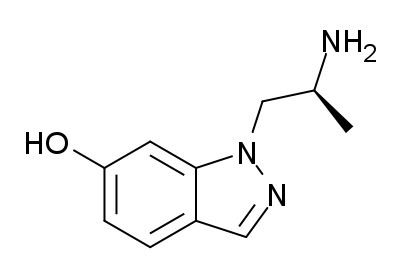CAS Number 210580-75-9 ChEMBL CHEMBL371300 3D model (Jmol) Interactive image | ChemSpider 21467821 Formula C10H13N3O Molar mass 191.229 g/mol | |
 | ||
Melting point 170 to 172 °C (338 to 342 °F) | ||
AL-34662 is an indazole derivative drug that is being developed for the treatment of glaucoma. It acts as a selective 5-HT2A receptor agonist, the same target as that of psychedelic drugs like psilocin, but unlike these drugs, AL-34662 was designed specifically as a peripherally selective drug, which does not cross the blood–brain barrier. This means that AL-34662 can exploit a useful side effect of the hallucinogenic 5-HT2A agonists, namely reduction in intra-ocular pressure and hence relief from the symptoms of glaucoma, but without causing the hallucinogenic effects that make centrally active 5-HT2A agonists unsuitable for clinical use. In animal studies, AL-34662 has been shown to be potent and effective in the treatment of symptoms of glaucoma, with minimal side effects.
Peripherally acting 5-HT2A agonists have been a rich field of research in recent years, with potential glaucoma treatments being the main proposed application for 5-HT2A agonists at present, as centrally acting agonists for this receptor tend to be hallucinogenic and thus have little medical use. While many novel, potent and selective 5-HT2A agonists have been developed for this application, retaining peripheral selectivity can be a problem, and several of the more lipophilic compounds closely related to AL-34662 such as those shown below, did cross the blood–brain barrier and produced hallucinogen-appropriate responding in animals.
